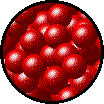

Two factors determine whether a substance is a solid, a liquid, or a gas:
If the average kinetic energy is greater than the attractive forces between the particles, a substance will not condense to form a liquid or a solid. If the kinetic energy is less than the attractive forces, a liquid or solid will form.
 |
| The average kinetic energy of the particles in a gas is great enough to overcome the forces of attraction between them. The molecules of a gas move apart when they collide. |
 |
| The average kinetic energy of the particles in a liquid (or solid) is small enough that the forces of attraction between them is sufficient to hold the particles close together. The molecules in a liquid (or solid) do not move apart. |
The first three forces are also collectively called van der Waals forces. All molecular and intermolecular attractive forces are electrostatic in nature. That is, they involve attractions between positive and negative species. The strengths of these attractive forces vary widely, though usually the intermolecular forces between small molecules are weak compared to the intramolecular forces that bond atoms together within a molecule.
All of the intermolecular forces that hold a liquid together are called cohesive forces.
